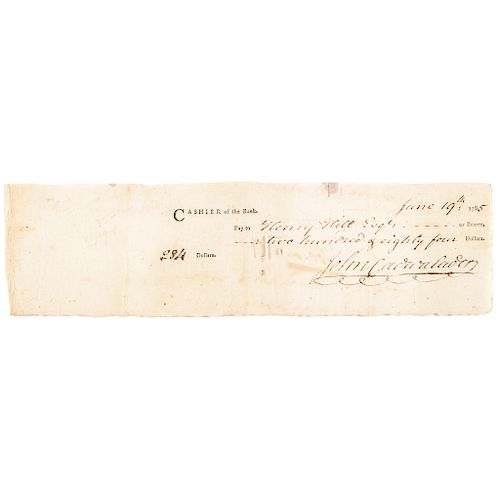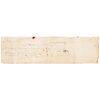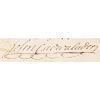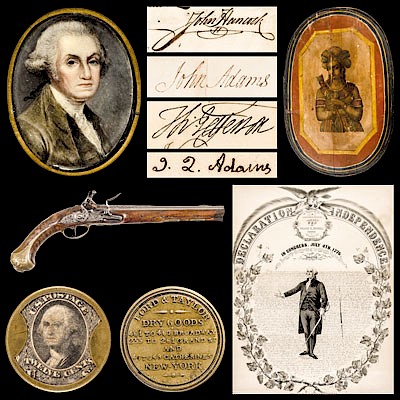1785 Check Signed JOHN CADWALADER, Rev War Commander of Pennsylvania Troops
Lot 13
Estimate:
$800 - $1,000
Absentee vs Live bid
Two ways to bid:
- Leave a max absentee bid and the platform will bid on your behalf up to your maximum bid during the live auction.
- Bid live during the auction and your bids will be submitted real-time to the auctioneer.
Bid Increments
| Price | Bid Increment |
|---|---|
| $0 | $10 |
| $200 | $20 |
| $300 | $25 |
| $500 | $50 |
| $1,000 | $100 |
| $2,000 | $200 |
| $3,000 | $250 |
| $5,000 | $500 |
| $10,000 | $1,000 |
| $20,000 | $2,000 |
| $30,000 | $2,500 |
| $50,000 | $5,000 |
| $100,000 | $10,000 |
| $200,000 | $20,000 |
| $300,000 | $25,000 |
| $500,000 | $50,000 |
About Auction
By Early American History Auctions
Jun 1, 2019
Set Reminder
2019-06-01 12:00:00
2019-06-01 12:00:00
America/New_York
Bidsquare
Bidsquare : Historic Autographs, Colonial Currency, Political Americana & Revolutionary War Era
https://www.bidsquare.com/auctions/early-american-history-auctions/historic-autographs-colonial-currency-political-americana-revolutionary-war-era-4152
Historic Autographs, Coins, Currency, Political, Americana, Historic Weaponry and Guns, John Adams, Thomas Jefferson, Early American History Auctions auctions@earlyamerican.com
Historic Autographs, Coins, Currency, Political, Americana, Historic Weaponry and Guns, John Adams, Thomas Jefferson, Early American History Auctions auctions@earlyamerican.com
- Lot Description
Autographs
Rare 1785 Check Signed "John Cadwalader" Commander of Pennsylvania Troops in the American Revolutionary War
JOHN CADWALADER (1742-1786). Commander of Pennsylvania Troops during the American Revolutionary War who served under General George Washington, and was with Washington during the Crossing of the Delaware River, Battle of Trenton, and at Valley Forge Camp.
June 19, 1785-Dated Post Revolutionary War, Partly-Printed Document Signed, "John Cadwalader", 8.25" x 2.25", 1 page, no place, Very Fine. Being an early Check made out to "Henry Hill Esq", in the amount of "two hundred & eighty four" Dollars. Small spindle cancel next to the "t" in two, otherwise well printed in black with rich brown manuscript portions and large nearly 3" long "John Cadwalader" signature. A scarce autograph, especially on a check. He died at the age of 43 a year later in 1786, leaving behind a large fortune.
John Cadwalader was born in Pennsylvania in 1742, the son of famous physician Dr. Thomas Cadwalader, and a cousin of John Dickinson, a delegate to the First and Second Continental Congress.
Cadwalader was a member of the Philadelphia Committee of Safety, captain of the city's "silk stocking" militia company, and a commander of a Pennsylvania militia regiment.
He planned to participate in Washington's famous surprise attack on Trenton in Decmber of 1776. Washington would cross the Delaware River north of the city, Cadwalader, south of it, and the Americans would surpise the Hessians on both sides. Unfortuantely, Cadwalader encountered difficulties getting his troops and cannon across the river, and remained on the PA side. Washington still managed to score a victory at Trenton, and Cadwalader was not held to be responsible for failing to show up for the engagement at Trenton. He and his forces did cross the following day, met up with Washington, and eventually forced the British from New Jersey.
By fall of 1777, Washington requested Cadwalader to organize militia on the Maryland eastern shore. He saw action at Brandywine, Germantown and Monmouth.
On the Fourth of July, 1778, Cadwalader, fiercely loyal to General Washington, fought a duel with Thomas Conway, leader of the Conway Cabal. He shot him in the mouth, but Conway recovered from the injury.
Cadwalader was offered several commissions to serve as a general in the Continental Army under Washington, but declined, electing instead to serve in the PA state militia.
Following the war, he moved from Philadelphia to Maryland, where he became a state legislator. He died at the age of 43 in 1786, leaving behind a large fortune.
Prior to the American Revolution, tension between colonial merchants and the English Parliament heightened after the British crown suggested tightening control over colonial trade. Parliament began passing a series of taxation laws, including the Stamp Act, which threatened the livelihood of colonial importers, including Philadelphia's John Cadwalader. Ironically, Cadwalader's house on Second Street would be used as a British general's headquarters during the ensuring war.
John Cadwalader became one of the most prominent revolutionaries during the War of Independence. Prior to the colonial rebellion, Cadwalader established a small business in Philadelphia with his brother Lambert, importing dry goods. After Cadwalader's business flourished, he married Elizabeth "Betsy" Lloyd. As a wedding gift to the newlyweds, Betsy's father, Colonel Edward Lloyd bought the couple a house on the west side of Second Street and Spruce Street.
After the couple settled in their new home, they began to furnish their home with extravagate tapestry and artwork. In 1772, the Betsy and John asked Charles Willson Peale to paint a series of family portraits to be hung throughout Cadwalader's luxurious mansion. As the patriotic uprising intensified, Cadwalader closed his business and became highly involved in politics. Later that year, Betsy's father, Colonel Lloyd invited John Cadwalader to visit George Washington in Virginia.
During the trip, Cadwalader and Washington developed a friendship as they discussed their opinions of the Acts of Parliament. At the height of the colonial rebellion, Cadwalader became a member of the Philadelphia Committee of Superintendence and Correspondence and enlisted in the Continental Army.
In October 1774, he rallied up eighty-four men and assembled the "Silk Stocking Company." Cadwalader transformed his home into a military training camp to prepare the volunteers for battle. Following the Battle of Lexington, he served under General Washington, as well as colonel of the Third Battalion of the Philadelphia Association of Volunteers. The following year, Cadwalader was elected a member of the Pennsylvania Provincial Assembly and attended the Pennsylvania State constitutional convention. He was ready to fight for the patriotic cause, assembled his battalion, and awaited orders from General Washington.
Once Congress heard the British defeated George Washington's army at the Battle of Brandywine and the Battle of the Clouds, many local residents and members of Congress abandoned their homes and fled the city. After the Redcoats' victory, General Howe seized Philadelphia and took control of the city.
Howe then spent the rest of the winter living in Cadwalader's family mansion on Second Street. Though the Americans were victorious and secured their independence, much of Philadelphia's rural-landscape was in shambles from the war, many homes in Society Hill, including Cadwalader's mansion, were still standing. However, today, the house that once sheltered John Cadwalader and General Howe is no longer. Yet, it is worthwhile to note that the plot on Second Street has great historical significance to the birth of America
- Shipping Info
-
Early American provides in-house worldwide shipping. Please contact us directly if you have questions about your specific shipping requirements.
-
- Buyer's Premium



 EUR
EUR CAD
CAD AUD
AUD GBP
GBP MXN
MXN HKD
HKD CNY
CNY MYR
MYR SEK
SEK SGD
SGD CHF
CHF THB
THB













